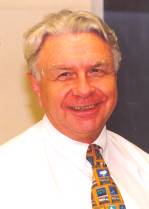Neil Kestner

Emeritus Professor - Quantum Methods -- Charles Barre Distinguished Professor
Bachelor's Degree(s): University of Wisconsin-Milwaukee, 1960
PhD: Yale University, 1964
PostDoc: University of Chicago, 1964-65
Phone: (225) 578-1528
Fax: (225) 578-3458
E-mail: kestner@lsu.edu
Office: 408 Choppin Hall
Area of Interest
We are involved in a number of theoretical chemistry projects as well as educational activities at the local and national level. Theoretical work involves primarily quantum chemistry but with some mixed quantum-statistical studies. Educational activities revolve around the use of computers in education, especially web based distance education.
Theoretical studies are mostly concerned with the transition between simple molecule behavior and bulk properties. Our earlier work centered on trapped electrons in clusters and bulk liquids. Recent work has concentrated on ions, especially halide ions in water and rare gas clusters as well as RNA and DNA amines with attached waters. With ions and electrons one tends to find cup-shaped areas which trap the species half on the surface and half inside for small numbers of solvent molecules. Only with large numbers of solvent molecules are the species true internal states. The properties can vary widely between these two types of states.
A new area of interest is the calculation of the properties and in particular, the electronic properties of Metcars, a new type of cage molecule discovered by Castleman at Pennsylvania State University. They have the general formula of T8C12, where T is a transition element such as Ti, Ru, or even mixtures. Since they can not yet be made in pure form, theoretical data is extremely important. However, due to the numbers of electrons and the complications of the high nuclear charges, these studies are not straightforward.
Two proposed structures for the Ti8C12 MetCar
Some of the educational activities involve being a co-leader of the chemistry discipline area on the MERLOT project (Multimedia Educational Resource for Learning and Online Teaching). Modules are available along with reviews at www.merlot.org.
The collection of learning materials associated with MERLOT is constantly growing. To ensure high quality items, these materials are reviewed by discipline faculty using review techniques based on the peer review of scholarly materials model. Eventually, the peer reviews will be added to the learning materials screen. Other features that help in the selection process are the assignments and user comments. As faculty use the learning materials, successful assignments can be added to the learning material thus sharing “what works” with the MERLOT community.
It is one example of how we are now using computers to teach and share information across the campus and around the world.
Awards & Honors
President, LSU Faculty Senate, 2000-2002
Fellow, AAAS
Alfred P. Sloan Fellow
Selected Publications
Randall W. Hall, Leslie G. Butler, Neil R. Kestner, and Patrick A. Limbach. Combining Feedback and Assessment via Web-Based Homework. Campus-Wide Information Systems, 1999, 16, 24-26
N.R. Kestner and J. Combariza. Basis Set Superposition Errors: Theory and Practice. Reviews of Computational Chemistry, 1999, 134,
N.R. Kestner, P.A. Limbach, R.W. Hall and L.G. Butler. If You Build It, Will They Come?. Campus-Wide Information Systems, 1999, vol. 16, numb. 5, 175-8
Former Ph. D. Students
Jia-an Yang PhD
Jean Logan PhD
David Copeland PhD
Bert Riemeschneider PhD
Tracy Broussard PhD
William Finley PhD
Vestal Shirley PhD